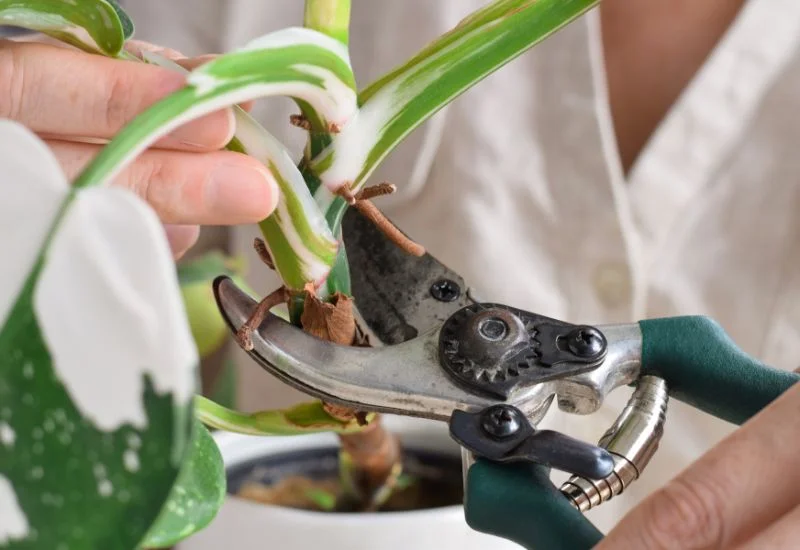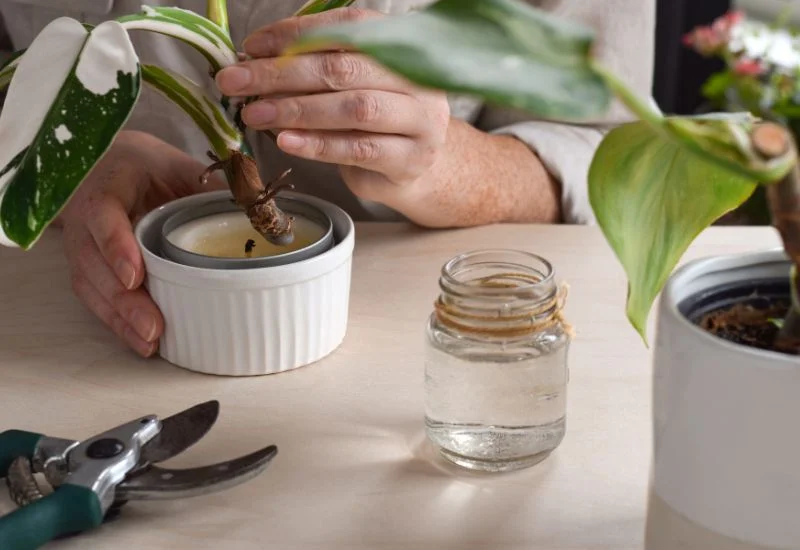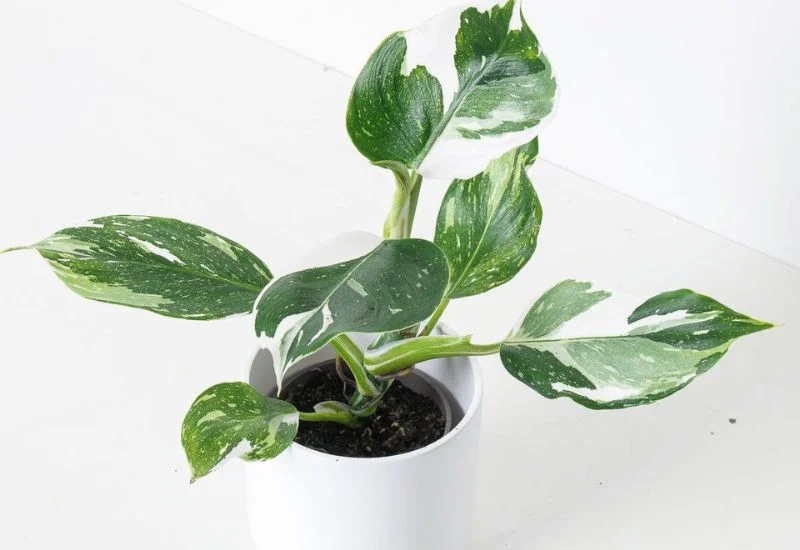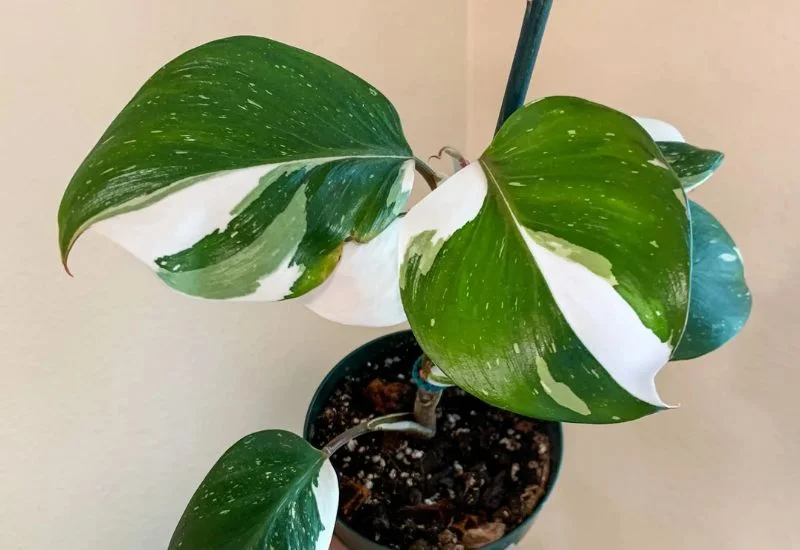In this blog post, you’re going to learn how to easily propagate and care for White Wizard Philodendron.
This is a comprehensive guide covering reliable information about different aspects of this cultivated variety.
In this post, I’ll cover:
- Interesting Facts
- Propagation
- Repotting
- Care
And
- Solutions to Common Problems
So, if you are looking to propagate and care for White Wizard Philodendron, this guide is for you.
Fun Facts
White Wizard Philodendron is an indoor plant with variegated leaves. The variegation appears in the form of large, bright, white patches on its large leaves. The species of this rare plant is Philodendron erubescens. Overall, the plant is small, which makes it suitable for small places.
These plants climb over other plants in the natural environment. However, they will form a bush-like appearance indoors.
| Common Name | White Wizard |
| Botanical Name | Philodendron erubescens ‘White Wizard’ |
| Family | Araceae |
| Plant Type | Perennial, vine |
| Mature Size | Two meters in height |
| Sun Exposure | 6 to 8 hours |
| Soil Type | Loose, well-aerated |
| Soil pH | Slightly acidic |
| Native Area | Colombia, South America |
| Toxic | Calcium oxalate crystals make it toxic. |
| Growth | Slow |
Growth period
White Wizard Philodendron takes two to three weeks to develop roots. In the first year, they will produce about six leaves in the spring season. However, in the upcoming growing seasons, they will have more leaves.
Leaves structure
Its leaves are narrow and pointed in the form of a heart. They are divided from the center and form a lobed structure. White and dark green variegations will appear on them.
Benefits
The Philodendron erubescens will never revert back. Once they get their white variegation, they will retain them permanently.
This plant needs a little care. Therefore, it is highly recommended for beginners. They can tolerate many environmental conditions which other plants can’t.
White Wizard Philodendron purifies the indoor air by taking the air pollutants such as formaldehyde and benzene. In this way, it is actually refreshing the air in your house.
Propagation

This philodendron species mainly grows from its stem cuttings. However, they can grow through seeds but very rarely. Here are some steps you can follow to propagate the White Wizard from a stem cutting.
- Make a stem cutting from a healthy plant with some leaves. For this purpose, use sharp, sterilized scissors. Moreover, cut the stem angled to increase the surface area.
- Now, you can place that cutting in the water or sphagnum moss. You have to keep the two-thirds part of the cutting in clean water until the roots appear. You have to wait for about three weeks for the roots. In this period, you maintain the cleanliness of water from algae. Moreover, for extra humidity, you can create a greenhouse over the container.
- After the roots grow up to one or two inches, you have to transfer this part to the soil. However, you have to prepare a soil mixture that is loose and well-drained. So that roots can propagate easily.
In this whole period of propagation, you have to maintain indirect, bright sunlight for a prolonged period of time. Moreover, the soil must be moist, but not too moist, to cause the roots to rot.
Repotting

White Wizard Philodendron is a slow-growing plant. Therefore, you may need to repot it after two years. Moreover, if roots are sprouting from the drainage holes, it is the best time to change the pot.
- Firstly, you have to remove the plant from the pot. Remove as much soil as possible from the container by squeezing and tilting the container. If the roots get stuck, you can soften the soil around using a knife.
- Now, prepare the soil mixture for the new container. The new pot must be a few inches larger in size. Hold the plant in the center of the container and pour the soil mixture around the plant.
- You should water to let the soil mixture settle. Maintain the original conditions that include the amount of indirect sunlight, humidity, temperature, and watering routine.
Initially, plants take time to adjust to their new home, but later, their growth speeds up.
Care

This is a tropical plant. Therefore, for ideal growth, you have to maintain conditions similar to those of their native habitat. However, you can easily maintain its ideal conditions by following the tips below.
Soil
The ideal soil mixture1 for all the philodendron species must be loose, soft, well-drained, rich in nutrients, well-aerated, and have a balanced water retention. To make such soil, you should go for the following constituents.
- Coco coir and peat moss are used to make a base.
- For drainage, you can use perlite, orchid bark, tree fern fiber, and coco coir chips in your soil mixture. This will also improve the aeration of your soil.
- Now, it’s time to add some nutrients. Slow-releasing and water-soluble fertilizers are used in the soil mixture to increase nutrients.
You can buy the soil mixture for your plant. However, it is recommended to make it by yourself. It will be not only cheap but also a controlled mixture.
Pot
For a baby plant, you can use a pot of about six inches. At the same time, you may need a larger pot of about ten inches for a mature White Wizard Philodendron. And every time you change the pot, you should select a two-inch larger pot.
There should be drainage holes in the walls of the pot. So that extra water can be drained out of the container easily. Moreover, prefer pots of clay or terracotta over plastic or metal pots.
Placement and Light
The variegated plants need more sunlight than normal plants. The White Wizard Philodendron has white patches in the leaves. These white patches don’t have chlorophyll. Only green parts of the leaves have chlorophyll and can make food through photosynthesis. Therefore, they will require longer periods of sunlight to make food for the whole plant. However, due to their delicacy, direct sunlight can damage the leaves. Therefore, only indirect sunlight can prove beneficial for this plant.
The placement of the plant directly affects the amount of light a plant receives. If you are placing your plant pot indoors, you should find a window that faces the sun from the east or north. Moreover, if proper sunlight is maintained, kitchens and washrooms are the best places due to high levels of humidity.
Easy Tip
Maintain eight to ten hours of indirect sunlight.
Water
This Philodendron is sensitive to both over-watering and under-watering. You have to maintain a consistent routine of watering for proper growth. You have to keep the soil moist but not enough to cause root rot.
Easy Tip
Water after the upper layer of the soil is completely dry.
You can touch the top layer of the soil with your finger. And water only when you feel completely dry soil.
Temperature
As these are tropical plants, they thrive well in high temperatures as compared to low temperatures. Moreover, they can tolerate high temperatures but will be damaged at low temperatures.
The ideal temperature for White Wizard Philodendron ranges between 60 to 85°F (15 to 29°C). Temperature below 50°F (10°C) will kill some tissues of this plant. However, it can tolerate an upper range of up to 90°F.
These plants prefer higher humidity levels. They can’t bear humidity lower than 30%. However, it shows the best results above 50%. To maintain higher humidity, you have to even install a humidifier.
Fertilizer
Fertilizing the plant once every month can boost its growth. Moreover, you can increase the frequency of fertilizing in the spring season due to fast growth. However, during the stunted growth times in fall and winter, over-fertilizing can cause root damage that results in plant death.
A balanced liquid fertilizer that has a percentage of 20:20:20 of nitrogen, phosphorus, and potassium is highly recommended.
Tips for fertilization
- Use liquid soluble fertilizers.
- Use more fertilizer during rapid growth.
- Use less fertilizers during the dormant phase.
- Customize the fertilizers according to the plant’s response.
Pruning
White Wizard Philodendron is known for its attractive variegated leaves. And no one wants to remove these leaves. However, you need to prune the dry, dead, yellow, brown, and infected leaves. You can cut these leaves with sharp shears from the nodes. In this way, you will not only make your plant look good but also protect it from disease.
Maintenance
These plants have large leaves, so they may need some support to grow. You can insert moss poles or little trellis so they can climb over them.
Moreover, their large leaves can collect a lot of dust after some weeks from the air. You can use a damp cloth to wipe the dust from the large leaves.
Common Problems

White Wizard Philodendron faces a number of problems due to different factors. Some of the most commonly seen problems are the following.
Pests
The pests such as red spider mites, mealybugs, aphids, whiteflies, thrips, fungus gnats, and scales can attack the leaves.
- Red spider mites2 form red films on the leaves, webbing them, and can damage them by making red-brownish spots on the leaves.
- Mealybugs are small in size and form a soft, white, cotton-like appearance through their secretions.
- Scales make the surface of the leaves shiny and sticky.
You can use neem oil, insecticide soap solution, alcohol solution, and mild pesticides through spray on these plants.
How to prevent pest attacks?
- Clean the pots and potting soil before use.
- Never touch the leaves with the leaves of another plant.
- Separate the infected plants from others.
Fungal Diseases
This Philodendron may develop leaf spots, yellowing of leaves, root rot, stem rot, and cotton-like masses on the leaves due to the fungus attack.
- A fungus named Phytophthora parasitica develops leaf spots in the form of lesions with yellowish-green margins and brown tips.
- A fungus infection named Anthracnose will turn your leaves yellow, which results in falling off of the leaves.
- Southern blight can cause stem or root rot. You can observe cotton-like masses over the infected areas.
You should trim the fungus-infected parts from the plant as soon as possible. Moreover, if the whole plant seems infected, you should remove that plant from other plants. You can use fungicides but these are harmful chemicals.
Curling Leaves
Underwatering causes the leaves to curl upward. They mostly develop such issues during cold seasons at low humid levels. You can treat them by maintaining a watering routine and increasing the humidity level through a humidifier.
However, curling of the leaves can happen due to overwatering. Water logging in the soil can cause downward curling of the leaves. So, the frequency of watering should be reduced.
Varieties & Similar Plants

There are two other species of Philodendron that can be confused with White Wizard due to similarities.
- Philodendron White Knights have leaves with green and white patches. However, they are distinct due to their burgundy stems.
- Philodendron Pink Princess comes with green, white, and pink colored leaves. Moreover, they don’t need any support to grow like other philodendron species or other vining plants.
Ready to Grab a White Wizard Philodendron to add beauty to your home garden?
All the above information is reliable, and you’ll see outstanding results if you want to grow or care for this plant.
Frequently Asked Questions
Article Sources
Aquariusmediaa provides reliable information with good-quality references to support the facts.
- The ultimate philodendron soil recipe. PLANT WORLD ↩︎
- . How to identify common houseplant pests.HOMESTEAD BROOKLYN ↩︎
